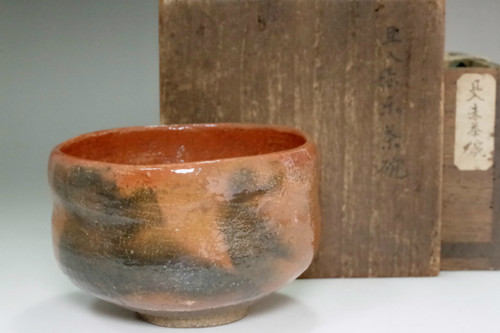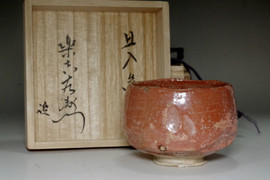10th Raku - Tannyu (1795-1854) Antique aka-raku tea bowl #3750
- SKU:
- 3750
- Shipping:
- Free Shipping
- width: approx. 10.5cm (4 9/64in)
- height: approx. 7cm (2 3/4in)
- weight: 239g (gross 420g)
The Tenth Raku - Tannyu (1795-1854)
9th generation, Ryonyu's second son. His father, Ryonyu retired at the age of 56, but since his older brother died young, Tannyu succeeded as the family head at the age of 17. He retired at the age of 51 and changed his name to Tannyu, taking the "Tan" character from Soutan from the Omotesen family 10th generation Kyukosai. Tannyu and the Kishu Tokugawa family came to have a deeper connection than ever before. In the second year of the Bunsei era when Tannyu was 25 years old, the 10th generation of the Kishu Tokugawa family, Lord Harutomi opened an Oniwa Yaki / Kairakuen kiln, and along with the Omotesen family 9th generation Ryoryosai and his father, Ryonyu, they established the kiln and made many works. It is interesting to note that a diary that Tannyu wrote at this time, called "Tannyu Diary", still remains and holds a detailed account of leaving Kyoto, the kiln construction, as well as daily conferences with the lord, and more, so the state of affairs at the time is well understood. Since then, he often traveled to Kishu and when he was 32 years old, he received a signature of the character "raku" from Lord Harutomi and he made it his own seal. At that time, he made many tea bowls, circulated this "Hairyo-in (bestowed seal)", and on the boxes he wrote, "bestowed letters from Kichizaemon from the first construction of late winter in the year of the dog (The eleven signs of the Chinese zodiac)." In addition, he also served when Kishu Tokugawa 11th generation, Lord Nariyuki opened an Oniwa Yaki / Seineiken kiln, and besides Raku, he made copies of Hagi, Karatsu, Oribe, Shino, and more. During this time, he used a seal that had "Seinei" written on it. Tannyu's style was developed from his father, Ryonyu's technique of modeling with a spatula, and shows various clever uses of the spatula. In addition, the tastes of the late Edo period and his experience with the Kishu Tokugawa family are reflected in his style, and he also incorporated styles from Kuni Yaki (Kuni Yaki indicates Japanese ware except for Seto ware) tea bowls such as Mino Yaki and Karatsu Yaki not seen in Raku Yaki before, as well as Kourai (Korean) tea bowls, and more. For example, on a Koudai (a foot part), while strongly chiseling away with a spatula, portions such as the Koudai-tatamitsuki are given detailed color which expresses detailed nuances of insect bites and chipping. Also, he used various seals, and by tracing each one the works' time and background can be understood. He even made a tea bowl called, "Su-in (multiple seals)", which is studded with the marks of these seals. By season, there were various seals such as the "Zen-in (former seal)" (also called Ki-raku seal) he used after taking his name, the "bestowed seal" he used around the period of the bestowed letters in the 9th year of the Bunsei era, the "Inkyo-in (retirement seal)" he used after taking residence, and the "Nenki-in (death anniversary seal)" from Kyukousai's writing used in the 9th year of the Tenpo era for Chojirou's 250th anniversary. In addition, the Raku family Buddhist altar is decorated with a sitting figure of Rikyu mady by Tannyu.




















